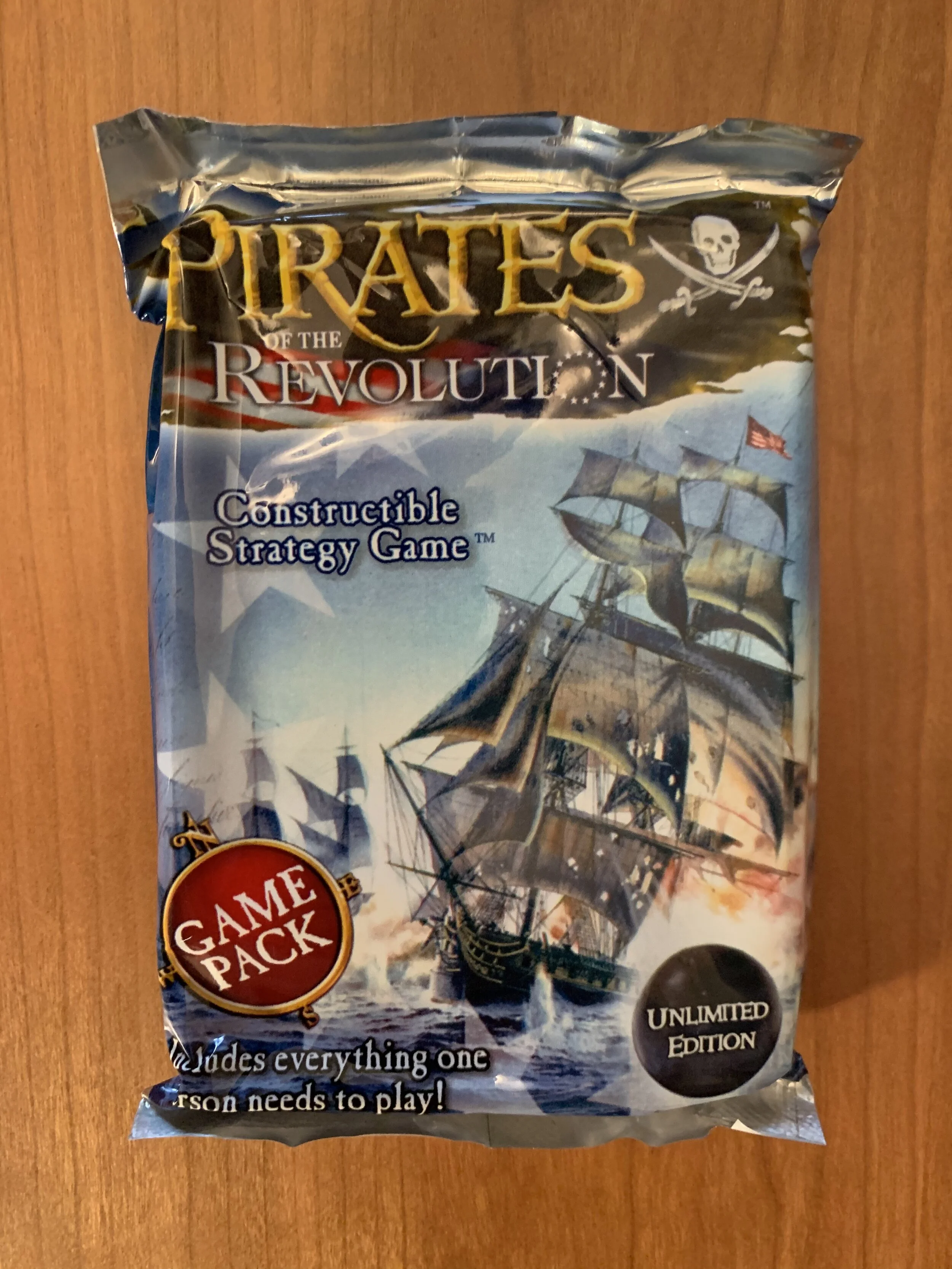Here There Be Pirates and Constructible Ships
The HMS Titan was a regal vessel. In the summer of 2004, it sailed my dining room table in search of pirate ships and hidden island treasures. No pirate sloop or Spanish armada could take her down. It was not until she tested some new waters, those of my friend’s living room floor, that she finally met her fiery end. Even her reinforced hull could not withstand the brutal force of an unsuspecting human foot. I watched in horror as the HMS Titan cracked into dozens of pieces. It was an unceremonious end to an otherwise valiant career for my favorite constructible pirate ship.
I was reminded of the tragedy of the Titan’s demise last Christmas when I received a nostalgic gaming present, six pristine packs of the Pirates Constructible Strategy Game.
A pack from the Pirates of the Revolution (2005) set.
Produced by WizKids, Pirates of the Spanish Main and the other expansions that would follow laid the foundation for a brand-new type of constructible tabletop gaming. Like other collectible card games, the Pirates series allowed customers to buy individual card packs. These packs were unique, however, in that each pack was self-contained enough that you could open just one up and start playing right away. A single pack typically included two ships, crew, treasure, an island, a small die, and a rulebook.
The contents of a single Pirates of the Revolution pack displayed on a table.
The overall goal of the game was to achieve victory by destroying your opponent’s ships and gathering treasure from the various islands. To begin playing, all you had to do was build a few constructible ships and punch out enough cardboard islands to create a map. The styrene cards contained pieces of a ship that could be punched out and assembled to create a miniature model. The rest of the card contained the stats for the ship as well as providing a measuring stick for how far the ship could move. For instance, a ship with a movement stat of “L + S” could move one full length of the long side of a card and then one full length of the short side of the card. The remaining styrene cards contained crew members that could be placed on ships and treasure coins to place on the islands. Future expansions added new constructible items like sea monsters and fortresses.
As I reflect on what made this game so fun for me as a child, I now see three main contributing factors: collectability, constructability, and playability.
The collectability aspect of the game is perhaps the simplest to explain. Taking its cue from popular TCG’s like Pokémon and Yu-Gi-Oh!, the game featured a collection of cards of various rarities. In addition, each pack included a checklist to remind you of the types of ships you could obtain in order to complete your desired fleet. The current TCG market on Ebay is evidence of people’s continued obsession with these types of collectible games.
It was the constructability, however, that took the excitement of this collecting to new heights. Perhaps it was due to my age and being in my formative educational years, but the prospect of building things really excited me. Whether it was Lego sets, or even board games with customizable maps like Heroscape, I loved taking physical materials and creating new things. By combining a collectible game with constructible objects, the Pirates series provided gamers with more delightful moments. While the Pokémon cards I collected just went into a binder, opening the Pirates card packs was really just the beginning of the adventure. Sure, there was the initial moment of delight when you opened the pack and saw your new cards, but there was also a second moment of even more delight which occurred when you built your ships. Admittedly, this ship building process was not always easy. You could spend long periods of time trying to bend the hull of the ship just far enough to pop into the deck. It was this building challenge, however, that made it all the more rewarding to see your fully built armada.
Ships from the Pirates of the Revolution set being constructed.
An image of a partially constructed ship in front of a fully built three mast ship.
I became so excited by this ship building process that I even took things a step further by buying a model of the USS Constitution to build for a class project. This helped the Pirates Constructible Strategy Game join the ranks of other historical games (Age of Empires, Total War, and Assassin’s Creed) in growing my academic interest in history.
Playability came in its easy-to-follow rules and the sheer delight of sailing the ships you had built around a tabletop ocean and testing their mettle against other formidable adversaries. The game packaging was also clever in that it provided everything you needed to play in a single pack. This made it easy and affordable to start playing for younger audiences who didn’t have the cash to build competitive TCG decks.
While the HMS Titan may not have survived that fateful summer day in 2004, my positive memories of the Pirates Constructible Strategy game still remain. While the game went out of print after 2008, I will keep the memory of the game alive for as long as I can. I think there is a lot to be said for the ability of a game to captivate one’s imagination and creativity as the Pirates games did for me.



